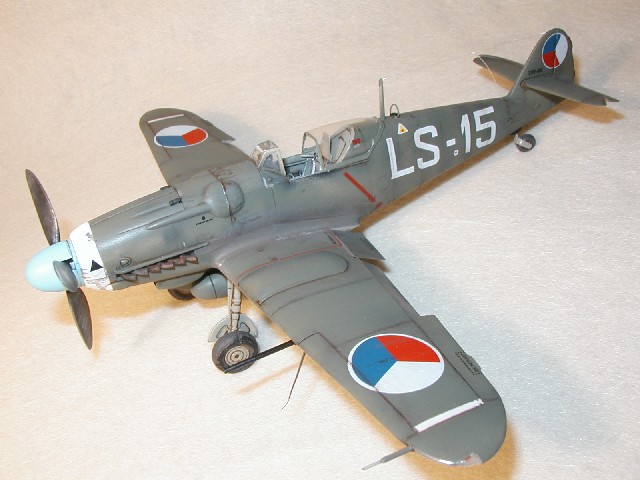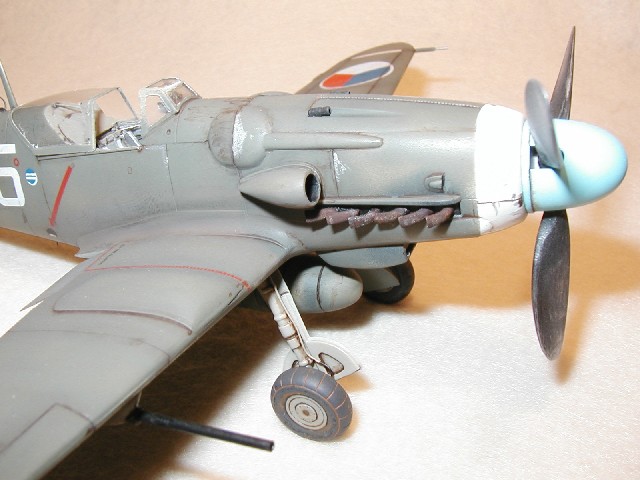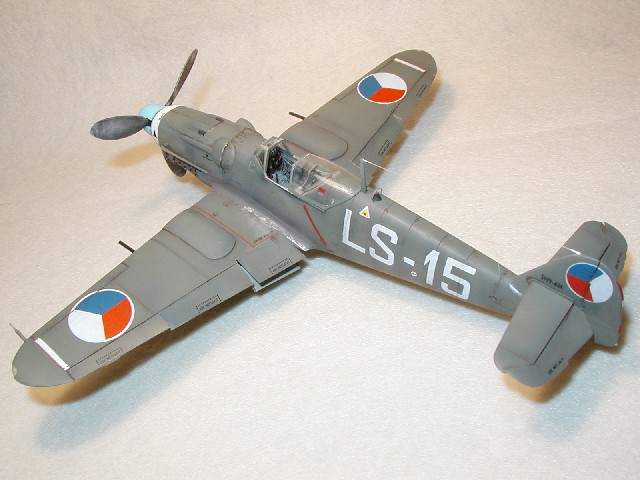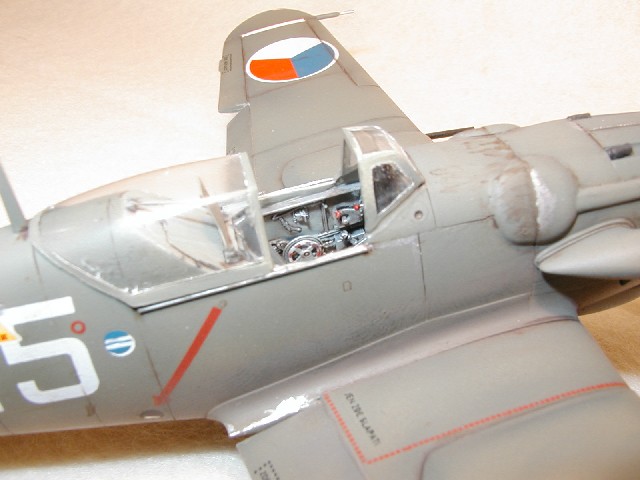|
Avia S.199
by Jose R. Rodriguez
|

|
|
Avia S.199 |

Academy's 1/48
scale Avia S.199 is available online from
Squadron.com
"Truth is stranger than fiction, but it is because Fiction is
obliged to stick to possibilities; Truth isn’t."
Mark Twain
The above quote aptly applies to the Avia S.199 in Israeli service. An
offspring of the aircraft that carried on its back much of the burden of
the Nazi Luftwaffe and its quest for the thousand year Reich ended up
being pivotal in the War of Independence of the Jewish nation. I don’t
think even Tom Clancy could have come with that possibility in any of
his books.
After WWII the Czechs were left with the remnants of aircraft factories
that had been used by the occupying Germans to build Messerschmitt
aircraft, in particular the Bf109 in the Gustav variant, or G model.
Avia was one of such factories with a good supply of Bf109G airframes
but with no Daimler-Benz engines. I read somewhere that the engines have
been destroyed by an allied air raid; other sources said it had been a
factory fire after the war. While the DB engines could not be had, there
was a good supply of Jumo 211F engines. The catch was that these engines
were designed for bombers; they had plenty of power but they were heavy,
and they developed a lot of torque at low R.P.M, like a truck engine.
The Czechs were undaunted by this fact and proceeded to match the Bf109G
airframe with the Jumo engine and thus one of the most disliked and
without doubt the worst 109 variant ever made, the Avia S.199, was born,
or ill conceived.
In 1947 the British had started pulling out of Palestine and Zionist
Jews had commenced what would be known as the War of Independence, a war
that created the state of Israel. The Zionists did not have a proper air
force but a ragtag squadron of mismatched light aircraft from which this
hardy people dropped hand grenades and fired infantry machine guns
through the windows. This outfit was called the "Shirut Avir" (air
service). When the regular armed forces of Egypt, Iraq and Syria invaded
Palestine after Ben Gurion proclaimed the existence of the state of
Israel, the Jews realized that they needed real aircraft to contest the
total air supremacy of the Arab air forces over Tel Aviv and what was
supposed to be the new nation of Israel.
Cloak-and-dagger operations got in motion worldwide trying to scrounge
fighters for the not yet existing Israeli air force. The Czech
government lent an ear to the Jewish request and was willing and able to
supply the fighters, for a good price. That those fighters were the Avia
S.199 and that they had to overpay for them matter none to the Jews
because the situation in Israel was desperate and beggars cannot be
choosers (another quote for you).
Money exchanged hands and a core of Jews and Gentiles (Machal
volunteers) showed up in Czechoslovakia to get trained in the
“Messerschmitt”, as the Avia was known to these men who had flown allied
planes, Mustangs and Spitfires, against the 109. The Czechs called the
Avia “Mezek” or Mule because of its stubborn handling. I doubt that was
an official name. The Israelis gave the Avia the official name of Sakin
or knife but unofficially continued to be called the “Messerschmitt” or
Mule.

This first group of pilots included two Machal volunteers, Lou Lenart
and Milton Rubenfeld (Pee Wee Herman’s dad), and eight Israeli Sherut
Avir pilots, Modi Alon, Ezer Weizman, Jacob Ben-Chaim, Pinchas Ben-Porat,
Itzchak Hennenson, Misha Kenner, Nachman Me'iri, and Eddie Cohen. Before
they could be properly trained news reached them that Egyptian bombers
had killed 42 people in Tel Aviv during a raid. The Israeli pilots
demanded to be sent back to Israel immediately with their Mules even
though they haven’t even completed gunnery training. They could practice
on real targets was their argument against the best advice of their
Czech mentors.
This unruly but dedicated bunch plus a few Czech mechanics hastily
departed for the Holy Land and by May 29th, 1948, they had four aircraft
assembled but not tested. The situation was desperate as an Egyptian
armored column was only 20 miles away from Tel Aviv and the only thing
in its way was an outnumbered, scattered and worn out Israeli army. Lou
Lenart, Modi Alon, Ezer Weizman and Eddie Cohen took off in their four
S.199s and found the Egyptians at a bridge near the Arab settlement of
Isdoud. They bombed, strafed them and brought havoc on the unsuspecting
Egyptians. From a military point of view this aerial assault was nothing
to write home about; mostly all the aircraft guns jammed because they
had never been test fired before, but the psychological effect on the
Egyptians of seeing Israeli combat planes, real planes, was devastating
on their morale. The Egyptian advanced stopped and it gave the Jewish
ground forces a respite to reorganize and counterattack. During this
action Eddie Cohen was downed by ground fire and to this day his remains
have not been found.
The May 29th attack also marked the official formation date of Israel's
first fighter squadron, the 101st "Hakrav Harishona" (First Fighter)
Squadron, commanded by Mordechai “Modi” Alon.
Modi Alon became the first Israeli pilot to down an enemy aircraft with
his Mule when on June 3rd, 1948 he shot down two Egyptian C-47’s bombing
Tel Aviv. The Egyptians until then have bombed the city with impunity
and nobody, neither Egyptians nor the people of Tel Aviv expected to see
a lonely Avia coming out of nowhere and blasting the Dakotas out of the
air. The morale boost to the Jewish civilian populace was beyond
measure, and so was the demoralizing effect on the Egyptians.
The Avia S.199 became the reluctant hero of the hour. Being at the right
time and the right place abated for its unforgiving handling but the
aircraft exacted a high toll from the Israeli and Gentile pilots who
flew it. Many pilots were killed in take off and landing accidents. The
Mule had a very heavy nose, too much torque during take off (full power)
settings, that combined with the infamous 109’s narrow wheel track made
take offs a risky venture. If the pilot survived the take off the
aircraft was still a handful because the engine did not develop the
right power at the right times. Landings with a nose heavy aircraft were
no piece of cake either. Modi Alon perished in a landing accident on
October 16th after a mechanical failure prevented his landing gear from
deploying. Amidst his attempts to lower the gear, his aircraft, D.114,
hit the ground and exploded.
Israel bought 25 Mules and 24 reached the Holy Land. The missing
aircraft was impounded by the Italians who were enforcing a UN arms
embargo against Palestine. Jewish operatives blew up the Macchi factory
that was building and shipping C.205’s to the Egyptians. I surmise that
there was no love lost among the parties involved. Of the 24 aircraft,
the Israelis were only able to keep a handful airworthy at any given
time. Combat, accidents and precarious maintenance resulted in high Mule
attrition and by 1949 only six were left, and Spitfires and Mustangs
quickly replaced them, the aircraft the Israeli pilots had wanted from
the beginning.
Despite its flaws, the S.199 covered itself with glory as the first
effective combat aircraft of the new born state of Israel. Its effect as
a morale booster probably surpassed its tactical accomplishments in the
battlefield.
Somehow the Czechs flew the type until 1955. I wonder how they pulled it
off.

But this is a Czech mule
Obviously something went wrong during my build, a usual occurrence.
Following Aires and Eduard instructions I built a sliding canopy for my
Avia, an option in both p.e. sets. The bubble canopy gave the aircraft a
sleek look. After everything was in place I got suspicious about the
fact that I haven’t seen an Israeli Mule with such canopy but with the
Erla Haube type instead. Checking the gurus in HyperScale confirmed my
suspicion; only the Czechs used the sliding canopy.
I could have unglued everything and start anew, or I could have built an
Israeli Avia with a sliding canopy and then hide it in the highest shelf
of my display and never tell anybody, or I could get the Czech decals
that Hobbycraft put out for the Czech version they offered not too long
ago. HyperScalers came to the rescue again and David Fry kindly sent me
a set of Czech decals, the ones you see in this model. Thank you Mr.
Fry.
Hobbycraft's
1/48 Scale Mule
|
This is Hobbycraft of Canada kit HC1540 in 1/48th scale of the Avia
S.199, made in South Korea. Hobbycraft is the underdog of the modeling
world and I believe they deserve better. Some hobbyists had come hard on
this company because of sparse cockpit detail and the Shape Police has
also been unkind to them, based on a few dogs they have put out. After
building a few 109 kits and having others in the box ready to build, I
can say that I like Hobbycraft’s Messerschmitts. Their 109 kits are
simple, fit well, have recessed panel lines, the instructions are good,
and the decals are well researched and rather usable. They are an
excellent value for the money and they cannot be beat on price. They are
not Tamigawa or Eduards, but you cannot buy a kit from any of these
brands for less than fifteen dollars either.
With that off my chest lets see the kit. It comes in one bag with three
gray sprues and one clear one. The fuselage sprue with the propeller is
used only in the Avia. The other two sprues containing the wings and
other details are marked 109G/K, which would be correct for this
airframe. There is no flash, no grease residue, no warped plastic, and
parts are well molded with a smooth surface. Cockpit detail is good but
it is not comparable to an expensive aftermarket resin add-on but it
should be enough for mostly any modeler who doesn’t want to fool with
the extra work and expense. There two canopy options, close and open.
Some of the parts will not be used because they don’t apply to the Avia.
The instructions are very well done and the painting and decaling
section is outstanding.
As usual, I started construction on the wings. I dread cockpit work
so I leave that for last. The wings are pure breed Bf109G-10. I cut the
mid-span flaps and split cooler flaps off. I deepened the ailerons and
leading edge wing slats panel lines to give them a deeper look that show
them to be a separate part of the wing structure. It took me a while to
figure out what to cut on how to cut so here is the skinny.
Leading edge slats: they are a free moving mechanism, i.e. there are no
mechanical actuators connected to these slats. They work on ram air
pressure. When the airspeed is high they are flush against the wing. As
the airspeed drops the pressure exerted by the airflow against them
decreases and they drop or slide forward increasing the wing chord and
providing better handling at low speeds. The big question is, when the
aircraft is parked on the ground, do the slats drop or stay flush? I
posted the question on the HyperScale forum and the consensus was that
both options were correct. Pictures show these slats to be anywhere from
flush to fully extended, with some aircraft having one of each and
anything in between. Ground crews would push them flush to avoid dirt
from getting into the slats and jamming them but other times nobody
would care. Anything you want to model will be correct. That was easy. I
left my slats retracted. I thought about scratch building them from beer
can aluminum to show them extended but it was a hassle to bend aluminum
in such a sharp radius around the wing leading edge so I took the easy
way out.
Glycol cooler split flaps: this contraction is a bit unusual. The inner
flaps, those flaps closer to the wing root, are the backend of the
under-wing glycol coolers. They automatically open and close in a
scissor fashion based on engine temperature, but they also can drop at
the same time to follow the path of the mid-span flaps when these are
dropped. I posted the question on how these things work in the
HyperScale forum and Mike Horrell suggested that I take a look at the
109 Lair site where this subject had been discussed before. My search
found a long posting from Mr. Graeme Snadden on how these flaps work. I
have summarized his explanations on the lines to follow.

An oft seen error when positioning flaps on a '109 is the relationship
between the split cooler flaps and the mid-span landing flaps. In
relation to the landing flaps when at the 40 degree full down position,
with the cooler flaps full open, the lower flap would be in line with
the landing flap and the top flap would be about 10 degrees below the
top surface of the wing (in line with the trailing edge of the wing
fillet). With landing flaps full down, in the automatic setting on
start-up from cold, the flaps would motor shut, leaving the lower flap
stationary whilst the top flap motored closed to leave a gap of about
125mm. Viewed in plan, this would mean that you would see the lower flap
protruding beyond the upper. If the pilot were to then raise the flaps
prior to taxiing, the cooler flaps would then come to a position where
they were symmetrically positioned with the chord of the wing with
little more than a 10mm gap at the trailing edge. On the ground, due to
the poor cooling capacity of the small radiators, the flaps would often
motor open whilst taxiing. With the landing flaps fully raised, the
opened cooler flaps would be symmetrically deployed about the midpoint
of the wing in cross section (fore & aft) with an angle of approximately
35degrees between them.
In case Mr. Snadden’s explanation wasn’t enough, HyperScaler Norman
Graf, pointed me to these pics of the split cooler flaps in a Spanish
Buchón, another 109 mutt with the much happier marriage of a Merlin
engine to a 109 airframe,
http://www.clubhyper.com/reference/BuchonWalkaround/images/wing/OilCooler01.htm
http://www.clubhyper.com/reference/BuchonWalkaround/images/wing/OilCooler02.htm
By the way, despite what the link address says, these are glycol (engine
coolant) radiators. The oil cooler is under the chin.
I used Eduard’s photo etched set to build the split flaps and the
radiators buried under the wings. This set is great but has small parts
and it takes some patience to put it together.
In a quick review, here are the modifications that I made to this kit:
-
Vacuum form canopy from Squadron, part
number 9563. Squadron provides both the Erla Haube and the bubble,
sliding canopies, one of each.
-
Resin cockpit from Aires, part 4020, with
tiny p.e. parts.
-
Eduard p.e. set for the flaps and other
small parts.
-
Electrical wire for the brake lines
-
Moskit exhaut pipes, part number 4856
-
Brass tubing cannons
-
The wing tips navigation lights were
carved out with a knife and filled in with Kristal Klear, which dried
into the right shape after letting the airplane hang nose down
overnight.
Options: green, green and green, RLM71 each time. I picked LS-15
because it had a white nose with a blue spinner. The blue spinner is
called out as FS25053, which of course I could not find at my hobby shop
so I used Russian Underside blue without having any clue whatsoever if
that is the right color hue. I started by painting the airframe white,
then preshading the panel lines with black and finally adding the RLM71.

All paints are acrylics and each was from a different manufacturer
(Tamiya, Polly S and Testors), using an Aztek airbrush. I sealed
everything with Future floor wax.
Weathering was done with acrylic artist paints diluted in soapy water
and chalk pastels. Paint chipping was done with enamel Testor Silver. A
final dull coat finished the job.
The Hobbycraft decals worked like a charm.
Another finished 109 without Swastikas, saved from ending as a
screwed up job by the wisdom and kindness of HyperScalers.
Buy Hobbycraft’s 109’s and have fun on the cheap; even straight out
of the box they build into nice models.
Click on the thumbnails
below to view larger images:
Images and Text Copyright © 2003 by
Jose Rodriguez
Page Created 18 December, 2003
Last Updated 17 March, 2004
Back to
HyperScale
Main Page
|
Home |
What's New |
Features |
Gallery |
Reviews |
Reference |
Forum |
Search